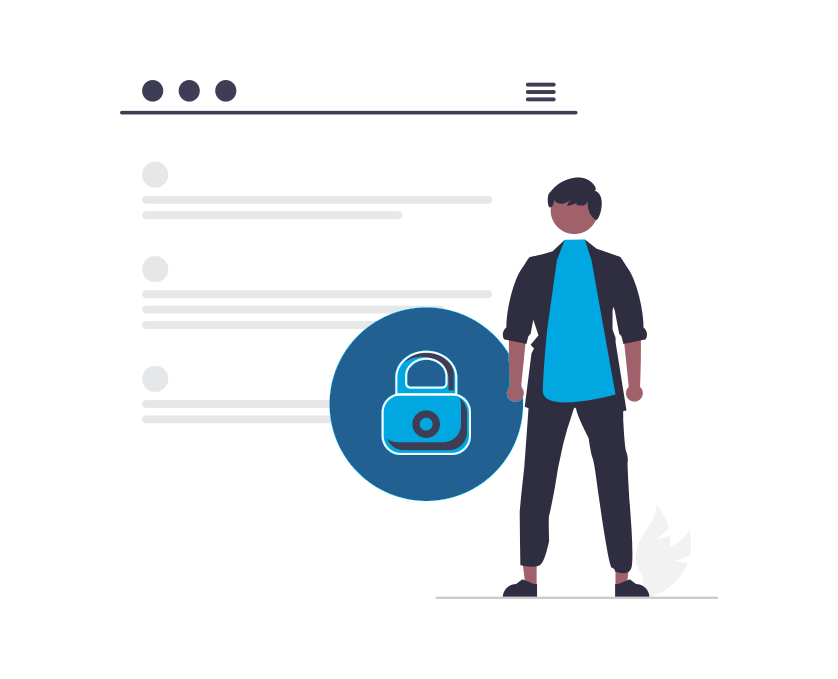Privacy and Security
Maintenance of practices to secure digital identity, recognize threats, and understand the broader safety implications of working in a digital environment.

Guiding Questions
- Am I aware of the permanence of my actions in a digital environment?
- Am I able to implement practices to secure my privacy, security, and well-being when using digital tools?
- Can I recognize online threats?

Context Why the skills in each domain are needed for digital opportunity, defined as "the condition in which individuals and communities have the information technology capacity that is needed for full participation in the society and economy of the United States" (H.R.3684)
Online privacy and cybersecurity is an often overlooked element of digital opportunity.19 Yet adults in the U.S. have become increasingly concerned about how their data is used, with the majority reporting that they have little to no understanding of what companies do with the data they collect (67 percent) and what the government does with the data it collects (77 percent). Thirty-four percent of U.S. adults also report experiencing the consequences of a data breach or hack in the past year.20 According to the Pew Research Center, building knowledge of online privacy, confidence in using devices, and concern about how companies use data can help individuals take action to be more secure online, although increased knowledge and concern can also lead to feeling—understandably—skeptical and overwhelmed.21
Awareness What practitioners should know before teaching each domain (e.g., related topics, factors that may affect learners)
Practitioners should be aware of the following when teaching privacy and security skills:
- Skeptical and overwhelmed reactions: As learners build knowledge and skills in this area, they may become more skeptical and overwhelmed about how to protect their own online privacy and security.22
- Digital presence: Some learners, such as refugees23 and those who’ve experienced domestic violence, may not be comfortable having any digital presence.
- Online threats: Certain learner populations are more likely to be the target of online threats.
- Artificial intelligence:Learners should be aware of how their personal information may be shared with or by means of artificial intelligence tools.
Taking Action What practitioners and programs can do to be inclusive when teaching each domain
Practitioners can take action to be inclusive in the following ways:
Instruction and Training
I can:
- Learn from learners and identify the challenges learners may face when it comes to privacy and security skills.
- Provide instruction on using privacy and security settings (e.g., two-factor authentication) on different devices.
- Acknowledge that learners’ reactions of skepticism and doubt can be healthy, and I can help them to navigate those feelings while supporting their right to make their own decisions about their privacy and security.
- Speak to the pros and cons of both building and minimizing a digital presence, depending on learners’ needs and goals.
- Provide instruction on the benefits and risks of artificial intelligence tools related to data sharing, privacy, and security.
- Emphasize the importance of recognizing and avoiding online threats for learners who are more likely to be the target of such threats, such as scams targeted at specific populations such as aging individuals and immigrants.
Program Design
Our program:
- Models strong privacy and security skills by having established policies and protocols to protect learner data and learner confidentiality.
- Regularly provides and/or shares information with staff on training and resources on privacy and security.
Related Inclusive Practices
See the following domains for relevant skills and related inclusive practices:
Communication, Creation, Device Ownership, Gateway Skills, Information Skills, Mobile, Online Life
Citations
19https://www.govtrack.us/congress/bills/117/hr3684/text/enr#link=F_III_60302_11_B_iii_~T1&nearest=H5E832360888448A58BCB00FD43A53994
20https://www.pewresearch.org/internet/2023/10/18/how-americans-view-data-privacy/
21https://www.pewresearch.org/internet/2023/10/18/a-deep-dive-into-online-privacy-choices/
22https://www.pewresearch.org/internet/2023/10/18/a-deep-dive-into-online-privacy-choices/
23https://www.unhcr.org/innovation/wp-content/uploads/2021/03/CWC-Managing-Digital-Risks-To-Refugee-Connectivity-Report.pdf





